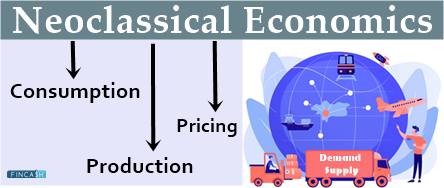
Table of Contents
What is Neoclassical Economics?
Neoclassical Economics is a theory that attempts to explain the production, pricing and consumption of goods and services by the supply and demand model. It first emerged in the 1900s and incorporates the cost of production theory from Classical Economics, including utility maximisation and marginalism.

Neoclassical economics primarily concerns the efficient allocation of resources in an Economy.
Examples of Neoclassical Economics
One of the crucial aspects of neoclassical economics is consumer perception. Consumers perceive a product or service as being more valuable than the cost of production, which often affects the demand for the product in the Market.
For instance, you wish to purchase a designer bag just because of the brand label. Here, the production cost of the bag may be nominal, but the perceived value exceeded its input cost, resulting in an economic surplus.
Neoclassical Economics vs Keynesian Economics
Keynesian economics includes various macroeconomic theories and models asserting how aggregate demand significantly influences economic output and Inflation. On the other hand, the neoclassical model emphasises aggregate supply, focusing on the main determinants of output and employment in the market.
Nonetheless, both the groups agree that aggregate supply and aggregate demand affect the entire course of the macroeconomy. Although Keynesians assert that demand is the most important determinant while supply just follows along, neoclassical asserts the opposite.
Talk to our investment specialist
Neoclassical Economics vs Classical Economics
Classical economics was introduced in the 18th century and includes the work of David Ricardo, Adam Smith and other economists. This theory states that the cost of a product or service is based on its cost of production. Here, this cost is calculated by different Factors of Production, including Capital, labour, Land and entrepreneurship.
Neoclassical economics is derived from classical economics, explaining the concept of marginalism. It states that people's decisions are based on margins, such as marginal cost, marginal utility, and marginal substitution rate.
Both classical and neoclassical economics are quite different in their theories and approaches. Classical economics says that the price of a product is independent of its demand in the market. On the other hand, neoclassical economics gives prominence to consumer demand. It states that factors like personal preferences and allocation of resources can influence product demand.
Talking of the approaches, neoclassical economics is based on mathematical models. In contrast, the study of classical economics implements more of a social and historical approach instead of a mathematical one.
Neoclassical Economics Assumptions
Several branches under neoclassical economics use different approaches. All of them are based on three primary assumptions:
- An Individual acts independently on complete and relevant information without bias.
- Consumers focus more on maximising utility, just like businesses maximise their profits.
- Individuals act rationally while selecting products and services. People make choices based upon advantage, personal preferences and outcome.
Conclusion
Neoclassical economics is primarily based on the premise that demand and supply forces are driven by consumers' attempts to maximise utility. It is mainly concerned with the valuable allocation of resources and considers the resources' growth in the long run. The development of resources will increase the production of goods and services, maintaining the market equilibrium.
All efforts have been made to ensure the information provided here is accurate. However, no guarantees are made regarding correctness of data. Please verify with scheme information document before making any investment.












